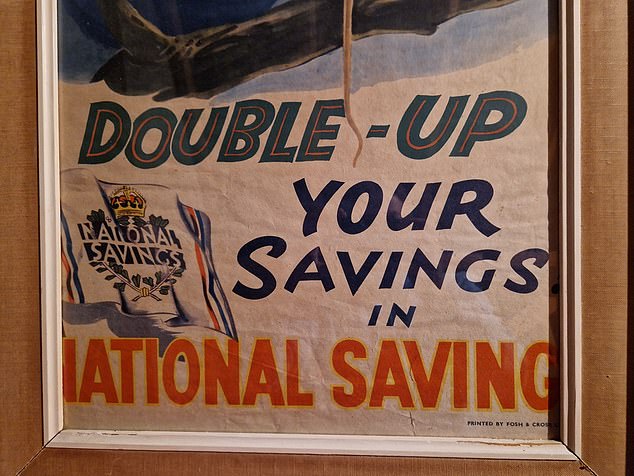Is my vintage NS&I poster worth a coin? I can’t find a similar one anywhere… replies DAN HATFIELD
I bought a National Savings poster for £50 as I liked the design. The poster features a small mouse, with a larger shadow in the background with the slogan: Double your savings.
It has a sort of war poster vibe to it and I will eventually reframe it and have it mounted in my home office.
The only information I have is what you can see on the poster – it was printed by a company called Fosh and Cross Ltd.
I’ve searched all over the internet looking for a similar poster but can’t find it anywhere.
I have no intention of selling but was wondering if you could give me a rough estimate of its value. Even though it costs less than £50 I don’t mind because I love the poster – I think it has character.
Character: It was difficult to date this National Savings poster… and put a value on it
Dan Hatfield, resident This is Money valuation experts, responds: There’s something delightful about this poster… it feels quintessentially British.
A serious subject, treated with a playful touch. Perhaps it’s our British reluctance when it comes to discussing money that inspired the designers to take a lighter approach.
A topic that is considered impolite to mention in polite society was made approachable and engaging, and this poster succeeds (and continues to succeed) in that mission.
NS&I (National Savings and Investments) was established in its earliest form in 1861 to help the government control its deficits.
Since 2017, approximately 9 percent of the national debt has been repaid through NS&I and its various products.
Placing your savings in this state-backed institution has proven extremely popular, especially as all deposits are fully guaranteed by HM Treasury.
It is interesting to note that the original purpose of NS&I, in addition to helping the government service its debts, was to help the public ‘fend for themselves against adversity and ill health’.
This reflects the context of the 19th century, a time before benefits, universal healthcare and state-funded pensions existed.
Individuals were largely responsible for their own financial security in the event of illness or job loss.
Such a plan would undoubtedly have appealed to many, and it remains attractive today from a purely profit-making perspective.
From the government’s perspective, NS&I kept the state running, and it was during the First and Second World Wars that the institution’s role became even more important and played a major role in financing the war effort.
During the First World War we first saw the rise of national savings products, including war bonds.
The government was in desperate need of money to continue financing a war.

Close-up: The poster has ‘printed by Fosh & Cross’ in the corner
Once again, during the Second World War, the public was encouraged – through posters such as the one in question – to use NS&I in support of the war effort. ‘Borrow to defend’ became a rallying cry.
Now to your poster: There is no mention of the war in the design. From this we can deduce that it was not produced during the First World War, and the lack of any reference to the Second World War also suggests that it was not produced during that period either.
Having come across countless NS&I posters at auctions, I must admit that I have not come across this particular design before.
Curious, I contacted NS&I for clarification, and the response was intriguing. it indicated that after some research it had found no record of this poster and no copy in their archives.
However, a few other posters were identified with the same National Savings flag, dating back to 1949.
Posters from the mid-1950s and 1960s typically featured more mature themes, such as landscapes and people, rather than whimsical illustrations like the mice in this one.
Based on this, I think your poster was probably made between 1950 and 1955. My theory is further supported by the fact that the poster promotes a scheme where lenders could double their money, a selling point that was heavily advertised in the 1950s and 1960s.
Normally, savers can double their investment over a ten-year period through accrued interest.
Valuing an item with so little documented history is difficult. This poster may have been produced in limited quantities.
After reviewing previous auction results, I found no record of sales of a similar item. I find myself intrigued, bewildered and excited by this discovery; it is quite a challenge to determine its value.
I would normally estimate an original NS&I poster similar to this at around £40 to £60 – about the price you paid.
However, given its rarity, it could perform well at more specialized auctions. Enthusiasts of NS&I memorabilia may be willing to pay a premium for such an unusual find, so I would suggest an estimated value of closer to £100, or possibly more.
In any case, it’s a fun and lively poster that certainly left this appraiser scratching his head. Whether you choose to sell it or simply enjoy it, it is a fascinating piece with a rich history.
Some links in this article may be affiliate links. If you click on it, we may earn a small commission. That helps us fund This Is Money and keep it free to use. We do not write articles to promote products. We do not allow a commercial relationship to compromise our editorial independence.


